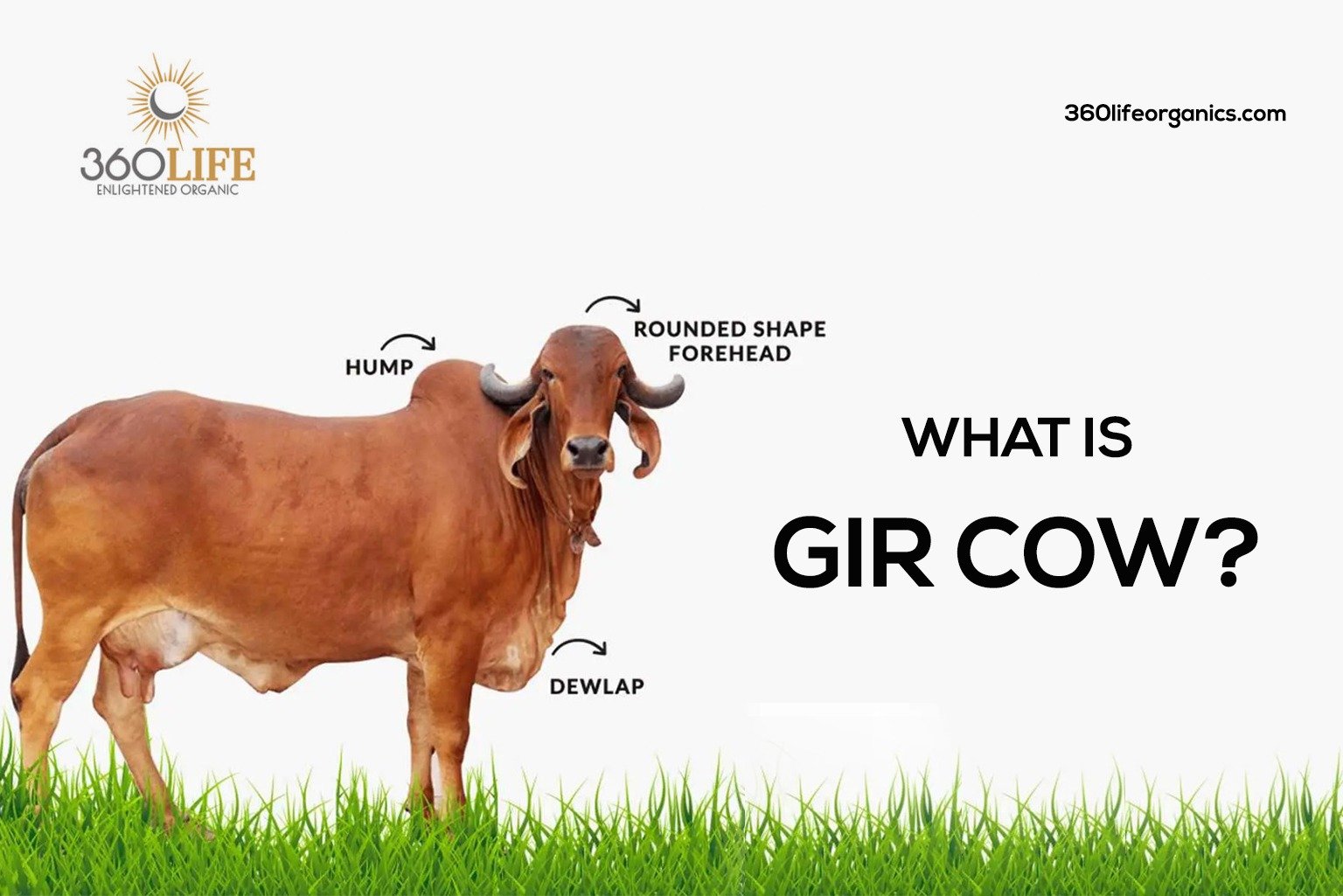Shopping Bag
No products in the cart.

A famous dairy cattle breed from India is called the Gir cow. Gir hills and Kathiawar woods are the cattle’s native range. This includes Amreli, Bhavnagar, Junagadh, and Rajkot in Gujarat. The Gir Forest inspired the breed’s name.
The Gir cow breed is well-known not just inside the borders of India but also around the world as a famous cattle breed. The importation of the Gir cow breeds involved nations like Mexico, Brazil, Venezuela, and the United States. These countries are successful in breeding them. As one of the common breeds utilized there to establish the Brahman breed, the Gir cow breed has grown in favor in North America.
Description of Gir cow
An important dairy cattle breed in India is the Gir. They are renowned for their extreme hardiness, ability to tolerate stressful situations, and resistance to a variety of tropical illnesses. Gir cattle are known for their high levels of social interaction. At night, they gather in a tight circle to sleep with their calves nestled under their shoulders. Gir cows normally produce 6 to 10 liters of milk each day. Cows are doing exceptionally well in India. In Brazil, each lactation results in an average milk production of 3,500 kg. The average lifespan of gir cattle is between 12 and 15 years. A cow also gives birth to 10–12 calves during her lifespan. It is a prevalent dairy cattle breed in India.
Physical characteristics
Gir Bulls and Cows typically weigh between 550 and 650 kg and 400 and 475 kg, respectively. Bull stands 1.35 meters tall, while gir cows are typically 1.30 meters tall. Their bodies range from red to white with white spots.
Although they can have a variety of body colors, from pure red to yellowish red to white when they have huge red dots, gir cows have a large, prominent, convex forehead that resembles a bone shield. The ears are long, pendulous, and have a knotted leaf-like fold on the tip. The horns are curved and move backward. Gir cow has a really long tail.
The udder is full-grown and rounded. They attract much attention because of their oddly curled horns. In contrast to other local cattle breeds, they have an uncommon and distinctive appearance due to their spheroidal, domed forehead with a noticeable and convex touch.
When exposed to solar rays, Surya Ketu Nadi (Vein) releases gold salts in its blood. These salts can be found in cow’s bodily fluids, including milk.
The Gir cow’s milk gives butter and ghee a natural golden hue. The combination of Gir cow’s milk, ghee, curd, urine, and feces is called “Panchgavya” in Ayurveda. This is also useful for fighting and curing many human and animal diseases. From Surya Ketu Nadi, we can find many important properties
MILK: Vitamins, Proteins, Minerals, Amino acids, phosphorus, Glucose, cerebrosides, strontyne, and Carotene with golden abstracts that are very helpful for our body.
DUNG: Nitrogen (N7), Potassium, Copper, Molybdenum, Borex, Cobalt Sulphate, Phosphorus, Irons, Manganese, Boron, Sodium. These properties of cow dung act as a natural fertilizer and are used as raw manure.
URINE: Calcium, Potassium, Magnesium, Phosphorus, Fluoride, Urea, Phosphorus, Ammonia.
The cancer virus can be killed by regularly consuming cow pee. Its urine aids in body purification maintains mental peace, and promotes physical wellness. The prevention of illnesses is another benefit.
Gir cows given below are the organic eatables that the Gir cow breed enjoys consuming very much –
Grain and other foodstuffs: maize, gram, wheat, barley, jowar, Bajra, rice polish, corn husk, oats, bran, peanut, sesame, linseed, cottonseed, crushed guar seed, triticale, tapioca, etc.
Dry fodder (hay): Garlic hay, Straw, Berseem hay, Oats hay, Maize pickle, Sugarcane fire, Oat pickle, etc.
Garlic, Berseem, Senji, Ryegrass, Guar, Bajra, Jowar (small), Napier Bajra, Maize (small), Sudan Grass, etc. are all examples of 100% organic and natural green fodder.
Other Important Foods: Drops of Wheat, Rice, and Corn; Bran; Rice Polish; Skins of Soybeans and Peanuts; Skins of Mustard Seeds; Skins of Cotton Seeds; etc.
Gir and Indian Desi Cow
Red Sindhi, Sahiwal, Kankrej, and Thar Parkar cattle are just a few of the breeds found in our state. Depending on their quality, these cows are classified as dairy (just for milk), dual (for milk and work-keeping), or work animals. Among all Desi cows in India, the Gir Cow is regarded as the BEST.
There are several more names for Gir Cow, including Bhadawari, Desan, Gujarati, Kathiawari, Sorthi, and Surati. South Kathiawar, Gujarat’s Gir Forest served as the Gir cow’s birthplace. Per lactation, 1200–1800 kg of milk is produced. Highly resistant to disease is this breed of cattle.
Key advantages of A2 gir cow
Gir cows have longer, less thick, and less furrowed necks. Its back bears a huge hump. These cows produce A2 milk, which is healthy and high in the A2 beta-casein protein. They are disease-free and less prone to illness. These cows can adapt to any kind of environment. Gir cattle can give birth to more than 10 to 12 calves during the course of their lifetime. Colostrum from this cow is comparable to “human mother’s milk”. This cow typically yields 6 to 10 liters of milk each day. Gir cows use a lot of fodder, thus care is expensive. Produced milk is very nutrient-rich.
Gir Cow is the only source of such magical nourishment, so it is important to support locally raised Gir cows in order to reap their lifelong health advantages.
At 360 Life Organics Goshala, our dedication to giving gir cows optimal care goes above and beyond the bare minimum. Our cows’ health and well-being are continuously monitored by a team of committed professionals at 360 Life Organics Goshala, who take preventive care measures and do routine checkups. In order to maintain the young cows’ optimal health, this also includes routine veterinary visits, deworming, and vaccines. At 360 Life Goshala, the cows’ emotional needs are as important as their dietary requirements.